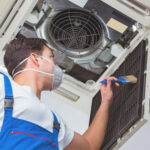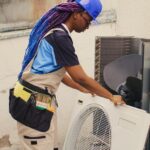
Tips for Improving Airflow in Your HVAC System
Tips for Improving Airflow in Your HVAC System
Airflow is the lifeblood of any HVAC system, crucial for maintaining comfort and efficiency in your home. Whether it’s the heat of summer or the chill of winter, ensuring proper airflow can significantly impact the effectiveness of your heating, ventilation, and air conditioning setup. From reducing energy costs to extending the lifespan of your system, optimizing airflow is a fundamental aspect of HVAC maintenance. In this blog post, we’ll explore some practical tips to enhance airflow and maximize the performance of your HVAC system.
Understanding the Importance of Airflow
Proper airflow within your HVAC system is akin to the steady heartbeat of your home’s comfort. It ensures that conditioned air is distributed evenly throughout your living spaces, regulating temperature and humidity levels effectively. Without adequate airflow, rooms may suffer from hot or cold spots, leading to discomfort and potential energy waste as your system struggles to maintain desired settings.
By grasping the significance of airflow, you can appreciate its impact on indoor air quality, energy efficiency, and overall comfort, motivating you to prioritize its optimization within your HVAC maintenance routine. Investing in airflow optimization not only enhances comfort but also reduces energy consumption and prolongs the lifespan of your HVAC system.
The Vital Role of HVAC Systems
Heating, ventilation, and air conditioning (HVAC) systems serve as the cornerstone of modern indoor comfort, providing a controlled environment regardless of external weather conditions. These complex systems work tirelessly to regulate temperature, humidity, and air quality, ensuring optimal living conditions year-round.
Central to their functionality is the efficient circulation of air throughout your home, facilitated by ductwork, filters, and fans. Without a well-functioning HVAC system, the comfort and health of occupants may be compromised, highlighting its vital role in modern living. Understanding and maintaining these systems is crucial for longevity, efficiency, and overall well-being.
Impact of Airflow on Comfort and Efficiency
The airflow within your HVAC system directly influences both the comfort levels and energy efficiency of your home. Proper airflow ensures that conditioned air reaches every corner of your living space, preventing uneven temperatures and maintaining a consistent level of comfort throughout. When airflow is restricted or inadequate, rooms may experience temperature imbalances, leading to discomfort and the need for higher energy consumption to compensate.
By optimizing airflow, you not only enhance comfort but also improve the efficiency of your HVAC system, resulting in lower energy bills and reduced environmental impact. Therefore, prioritizing airflow optimization is essential for achieving a comfortable and sustainable indoor environment.
Seasonal Considerations for Airflow
As the seasons change, so do the airflow dynamics within your HVAC system. During the summer months, prioritizing airflow becomes crucial to ensure efficient cooling and ventilation. Blocked vents, dirty filters, or obstructed ducts can impede airflow, causing your air conditioner to work harder and less effectively. Conversely, in winter, maintaining proper airflow is essential for efficient heating distribution and preventing cold spots.
By adjusting airflow strategies according to seasonal needs, you can optimize comfort, minimize energy consumption, and extend the lifespan of your HVAC system. Adapting airflow management ensures year-round reliability and performance, regardless of external weather conditions.
Energy Savings through Optimized Airflow
Optimizing airflow in your HVAC system isn’t just about comfort—it’s also a smart way to save on energy costs. When airflow is restricted or uneven, your system has to work harder to maintain desired temperatures, leading to increased energy consumption and higher utility bills.
By ensuring that air flows freely through clean filters and unobstructed ducts, you can reduce the workload on your HVAC system and improve its overall efficiency. This not only translates to lower utility bills but also contributes to a more sustainable lifestyle by reducing your carbon footprint. Investing time and effort into optimizing airflow can lead to significant long-term energy savings and environmental benefits.
Longevity Benefits of Proper Airflow
Proper airflow isn’t just essential for comfort and energy efficiency—it also plays a crucial role in extending the lifespan of your HVAC system. When airflow is restricted due to dirty filters, blocked vents, or faulty ductwork, your system has to work harder to maintain desired temperatures.
This increased workload can put excessive strain on components such as the blower motor, compressor, and evaporator coil, leading to premature wear and tear. By ensuring that airflow is unimpeded and balanced, you can reduce the likelihood of breakdowns and prolong the life of your HVAC system, saving you money on repairs and replacements in the long run.
Common Issues Hindering Airflow
Several common issues can hinder airflow within your HVAC system, leading to discomfort and reduced efficiency. One common culprit is dirty or clogged air filters, which restrict the flow of air and force your system to work harder. Blocked vents or registers, whether due to furniture placement or obstructions, can also impede airflow. Leaks in ductwork are another prevalent issue, allowing conditioned air to escape and reducing efficiency.
Additionally, improperly sized ducts or a malfunctioning blower motor can further hinder airflow. Identifying and addressing these issues promptly is essential to ensure optimal performance and comfort from your HVAC system, minimizing energy waste and enhancing indoor air quality.
Simple Steps to Improve Airflow
Improving airflow in your HVAC system doesn’t have to be complicated. Start by regularly replacing air filters to ensure they’re clean and free from debris, allowing air to flow freely. Clear any obstructions from vents and registers, ensuring they’re not blocked by furniture or curtains, to maximize airflow distribution. Consider installing vent deflectors to direct airflow where it’s needed most, optimizing comfort levels.
Inspect ductwork for leaks and seal any gaps or cracks with duct tape or mastic sealant to prevent air leakage. Finally, schedule regular maintenance with a professional HVAC technician to identify and address any issues affecting airflow, ensuring your system operates efficiently and effectively for optimal comfort and energy savings.
Professional Solutions for Airflow Optimization
Maintaining optimal airflow in your HVAC system is crucial for home comfort and efficiency. If DIY solutions are insufficient, professional assistance may be needed to address complex issues. Here are four professional solutions for airflow optimization:
- Duct Cleaning: Professional duct cleaning is a process that involves using specialized equipment to thoroughly clean the interior of your ducts, removing built-up debris and improving airflow in your home.
- Duct Sealing: Professional duct sealing is crucial to prevent leaks and gaps in ductwork, ensuring efficient airflow and preventing conditioned air from escaping, using mastic sealant or metal tape.
- Duct Resizing: Professional HVAC technicians can assess ductwork for improper sizing, recommending resizing or modifications to optimize airflow and improve system performance.
- Blower Motor Adjustment Or Replacement: The blower motor is crucial for HVAC system airflow, and malfunctioning or suboptimal operation can reduce efficiency. Professional technicians can diagnose issues, make adjustments, or replace the motor to improve performance.
Monitoring and Maintaining Airflow
Monitoring and maintaining airflow within your HVAC system is essential for ensuring optimal performance and comfort. Regularly inspect vents, registers, and air filters to ensure they’re clean and unobstructed. Use a handheld anemometer to measure airflow at various vents throughout your home, ensuring consistency and identifying any areas with restricted airflow.
Consider installing a smart thermostat with airflow monitoring capabilities, allowing you to track airflow patterns and detect abnormalities remotely. Additionally, schedule routine maintenance with a qualified HVAC technician to inspect ductwork, clean components, and address any issues that may be affecting airflow.
Signs Your HVAC System Needs Airflow Attention
Ensuring proper airflow within your HVAC system is crucial for maintaining comfort and efficiency in your home. When airflow is compromised, it can lead to a range of issues that affect your system’s performance. Here are four signs that your HVAC system may need airflow attention:
- Uneven Temperatures: If you notice that certain areas of your home are consistently warmer or cooler than others, it could indicate that airflow is unevenly distributed. This may be due to blocked vents, dirty filters, or ductwork issues.
- Weak Airflow From Vents: If you feel like the airflow coming from your vents is weaker than usual, it could be a sign of restricted airflow. This may be caused by dirty or clogged filters, blocked vents, or ductwork obstructions.
- Increased Energy Bills: Reduced airflow can cause your HVAC system to work harder to maintain desired temperatures, leading to higher energy consumption and increased utility bills. If you notice a significant spike in your energy costs, it may be due to airflow issues.
- Excessive Dust Buildup: Restricted airflow can cause dust and debris to accumulate within your ductwork and around your vents. If you notice excessive dust buildup in your home, despite regular cleaning, it could be a sign that your HVAC system’s airflow needs attention.
Maximizing Comfort with Enhanced Airflow
Enhancing airflow within your HVAC system is key to maximizing comfort and enjoyment in your home. Start by ensuring that vents and registers are unobstructed and clean, allowing air to flow freely throughout your living spaces. Consider upgrading to high-efficiency air filters to remove more contaminants from the air while allowing for better airflow.
Installing ceiling fans can also help distribute air more effectively, reducing the workload on your HVAC system and enhancing comfort. Additionally, scheduling regular maintenance with a qualified technician ensures that your system operates efficiently, providing consistent airflow and optimal comfort year-round.
Optimizing airflow in your HVAC system is essential for maintaining comfort, efficiency, and indoor air quality in your home. By implementing the tips discussed in this guide, you can enhance airflow and ensure your system operates at its best year-round. However, if you encounter any challenges or need professional assistance with your HVAC system, don’t hesitate to reach out to us at Cool Factory, Inc.
Our experienced technicians in Sterling, VA, are ready to help. Contact us today at (703) 713-5113 to schedule a consultation or maintenance service. Let’s work together to ensure your HVAC system provides optimal performance and comfort for you and your family.






